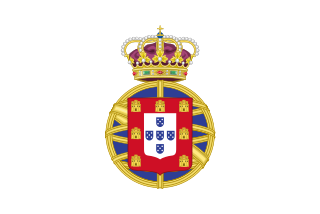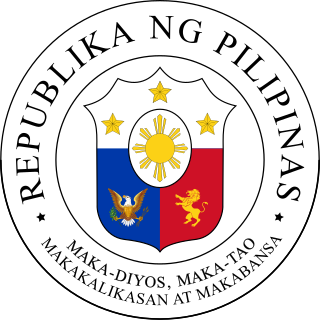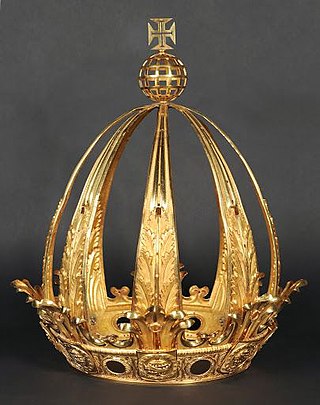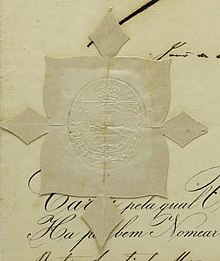
The coat of arms of the Philippines features the eight-rayed sun of the Philippines with each ray representing the eight provinces which were placed under martial law by Governor-General Ramón Blanco Sr. during the Philippine Revolution, and the three five-pointed stars representing the three major island groups of Luzon, the Visayas, and Mindanao.

The "Brazilian National Anthem" was composed by Francisco Manuel da Silva in 1831 and had been given at least two sets of unofficial lyrics before a 1922 decree by president Epitácio Pessoa gave the anthem its definitive, official lyrics, by Joaquim Osório Duque-Estrada, after several changes were made to his proposal, written in 1909.

The national flag of Brazil, is a blue disc depicting a starry sky spanned by a curved band inscribed with the national motto "Ordem e Progresso", within a yellow rhombus, on a green field. It was officially adopted on 19 November 1889 — four days after the Proclamation of the Republic, to replace the flag of the Empire of Brazil. The concept was the work of Raimundo Teixeira Mendes, with the collaboration of Miguel Lemos, Manuel Pereira Reis and Décio Villares.

The Flag of Portugal is the national flag of the Portuguese Republic. It is a rectangular bicolour with a field divided into green on the hoist, and red on the fly. The lesser version of the national coat of arms of Portugal is centered over the colour boundary at equal distance from the upper and lower edges. Its presentation was done on 1 December 1910, after the downfall of the constitutional monarchy on 5 October 1910. However, it was only on 30 June 1911, that the official decree approving this flag as the official flag was published. This new national flag for the First Portuguese Republic, was selected by a special commission whose members included Columbano Bordalo Pinheiro, João Chagas and Abel Botelho.

The Most Serene House of Braganza, also known as the Brigantine dynasty, is a dynasty of emperors, kings, princes, and dukes of Portuguese origin which reigned in Europe and the Americas.

The coat of arms of Brazil was created on 19 November 1889, four days after Brazil became a republic. It consists of the central emblem surrounded by coffee and tobacco branches, which were important crops in Brazil at that time. In the round shield in the center, the Southern Cross can be seen. The ring of 27 stars around it represents Brazil's 26 states and the Federal District.

The coat of arms of Germany displays a black eagle with a red beak, a red tongue and red feet on a golden field, which is blazoned: Or, an eagle displayed sable beaked langued and membered gules. This is the Bundesadler, formerly known as Reichsadler. It is one of the oldest coats of arms in the world, and today the oldest national symbol used in Europe.

The coat of arms of Russia derives from the earlier coat of arms of the Russian Empire. Though modified more than once since the reign of Ivan III (1462–1505), the current coat of arms is directly derived from its medieval original, with the double-headed eagle having Byzantine and earlier antecedents. The general tincture corresponds to the fifteenth-century standard.

The eagle is used in heraldry as a charge, as a supporter, and as a crest. Heraldic eagles can be found throughout world history like in the Achaemenid Empire or in the present Republic of Indonesia. The European post-classical symbolism of the heraldic eagle is connected with the Roman Empire on one hand, and with Saint John the Evangelist on the other.

The Imperial Crown of Brazil, also known as the Crown of Dom Pedro II or as the Diamantine Crown, is the Crown manufactured for the second Brazilian Emperor, Pedro II.

The coat of arms of Portugal is the main heraldic insignia of Portugal. The present model was officially adopted on 30 June 1911, along with the present model of the Flag of Portugal. It is based on the coat of arms used by the Kingdom of Portugal since the Middle Ages. The coat of arms of Portugal is popularly referred as the Quinas.

The Jewels of the Empire of Brazil were the official ornaments and regalia worn by the Emperor of Brazil during the Brazilian monarchical period. They were used by the Brazilian Imperial Family until 1889, among them the famous Crown of Dom Pedro II. Part of the jewels are on display at the National Museum of Brazil in Rio de Janeiro, and others have been at the Imperial Museum of Brazil in Petrópolis since 1943. Some are also in Brasília.

The Reichsadler is the heraldic eagle, derived from the Roman eagle standard, used by the Holy Roman Emperors and in modern coats of arms of Germany, including those of the Second German Empire (1871–1918), the Weimar Republic (1919–1933) and Nazi Germany (1933–1945).

The Kingdom of Brazil was a constituent kingdom of the United Kingdom of Portugal, Brazil, and the Algarves.

The Imperial Order of Our Lord Jesus Christ, simply named Order of Christ, is an order of chivalry instituted by emperor Pedro I of Brazil on 7 December 1822, on the basis of the Portuguese Order of Christ founded by King Dom Dinis and Pope John XXII in 1316–1319.

Paço de São Cristóvão was an imperial palace located in the Quinta da Boa Vista park in the Imperial Neighbourhood of São Cristóvão, Rio de Janeiro, Brazil. It served as residence to the Portuguese Royal Family and later to the Brazilian Imperial Family until 1889, when the country became a republic through a coup d'état deposing Emperor Pedro II. The palace briefly served as a public building by the provisional government for the constituent assembly of the first republican constitution. It housed the major part (92.5%) of the collections of the National Museum of Brazil, which, together with the building, were largely destroyed by a fire on 2 September 2018.

The Brazilian nobility refers to the titled aristocrats and fidalgo people and families recognized by the Kingdom of Brazil and later, by the Empire of Brazil, dating back to the early 19th century, when Brazil ceased to be a colony of the Kingdom of Portugal. It held official status until 1889, when a military coup d'état overthrew the monarchy and established the First Brazilian Republic.
A national coat of arms is a symbol which denotes an independent state in the form of a heraldic achievement. While a national flag is usually used by the population at large and is flown outside and on ships, a national coat of arms is normally considered a symbol of the government or the head of state personally and tends to be used in print, on armorial ware, and as a wall decoration in official buildings. The royal arms of a monarchy, which may be identical to the national arms, are sometimes described as arms of dominion or arms of sovereignty.

The Great Seal of the Philippines is used to authenticate official documents of the government of the Philippines.

The crown of Pedro I is the first imperial crown of Brazil and was made for emperor Pedro I of Brazil. It was made in 1822 for his coronation and was the symbol and emblem of Brazilian imperial power until it was replaced in 1841 by the crown of his son and successor Pedro II. It is one of the jewels of the Brazilian Empire and is now on display at the Imperial Museum in Petrópolis.





















